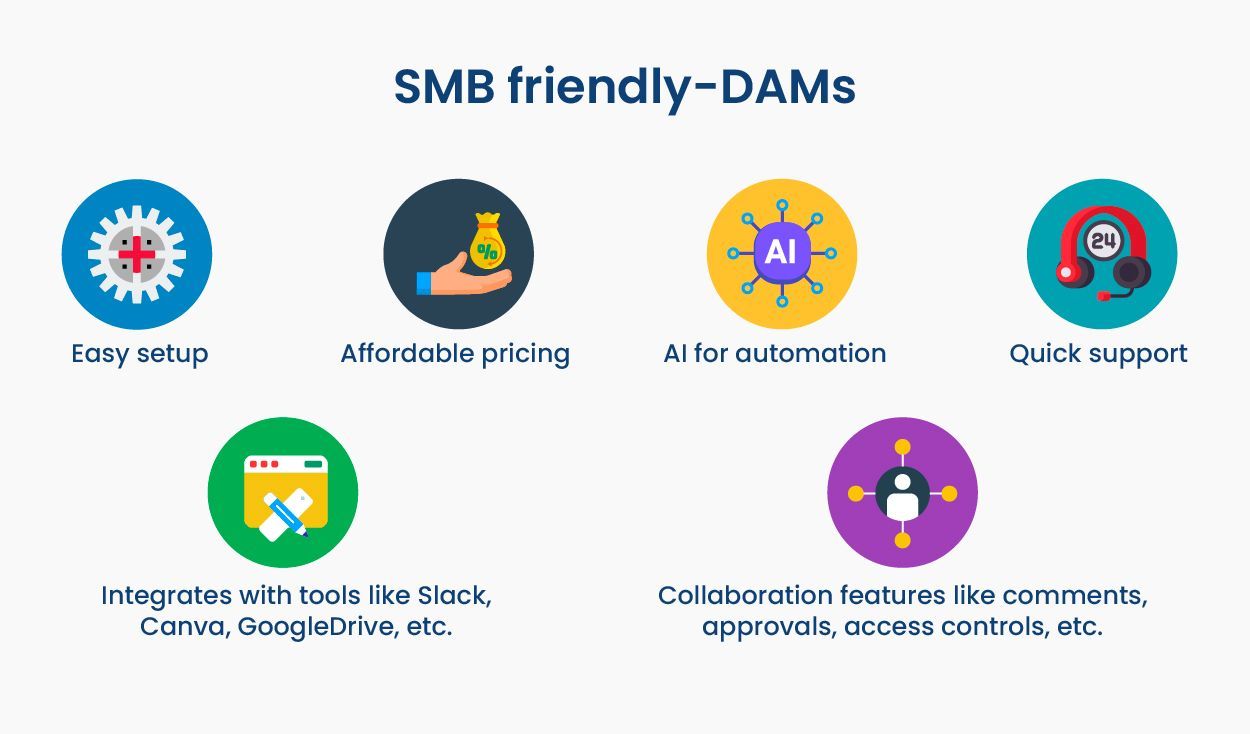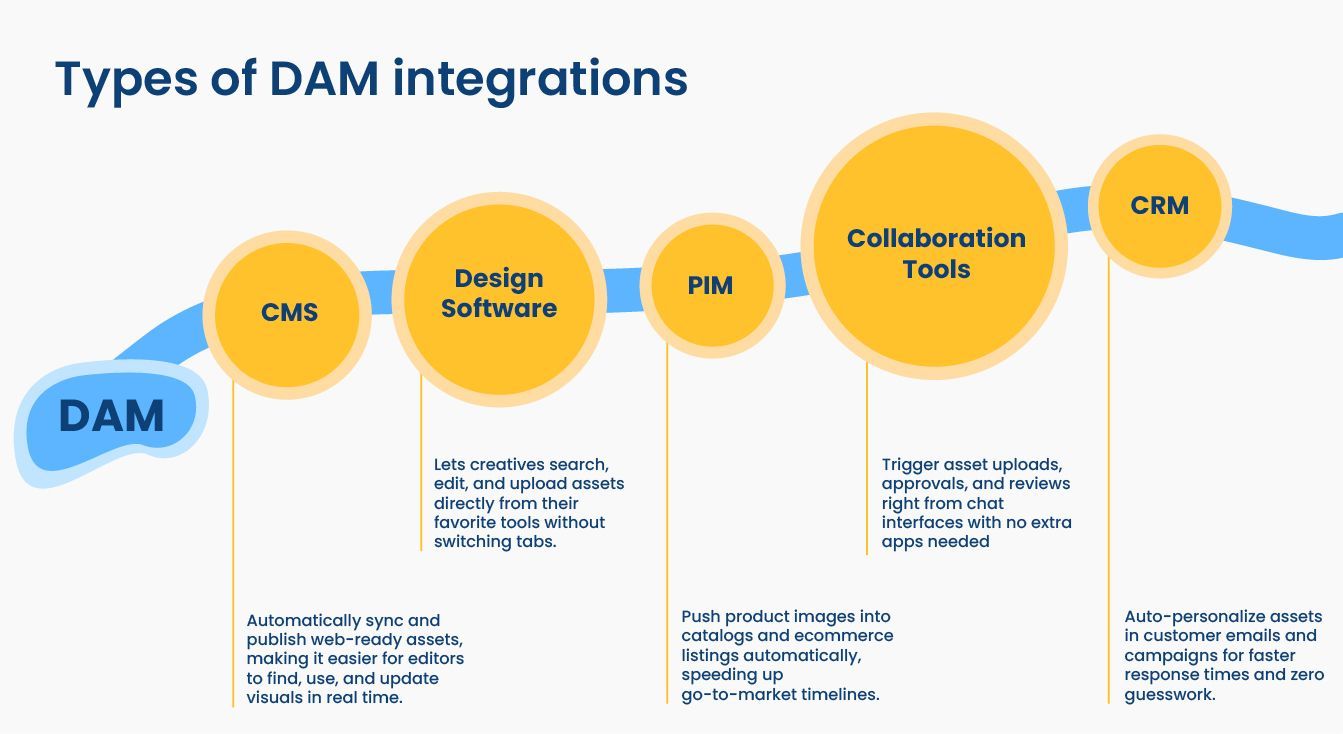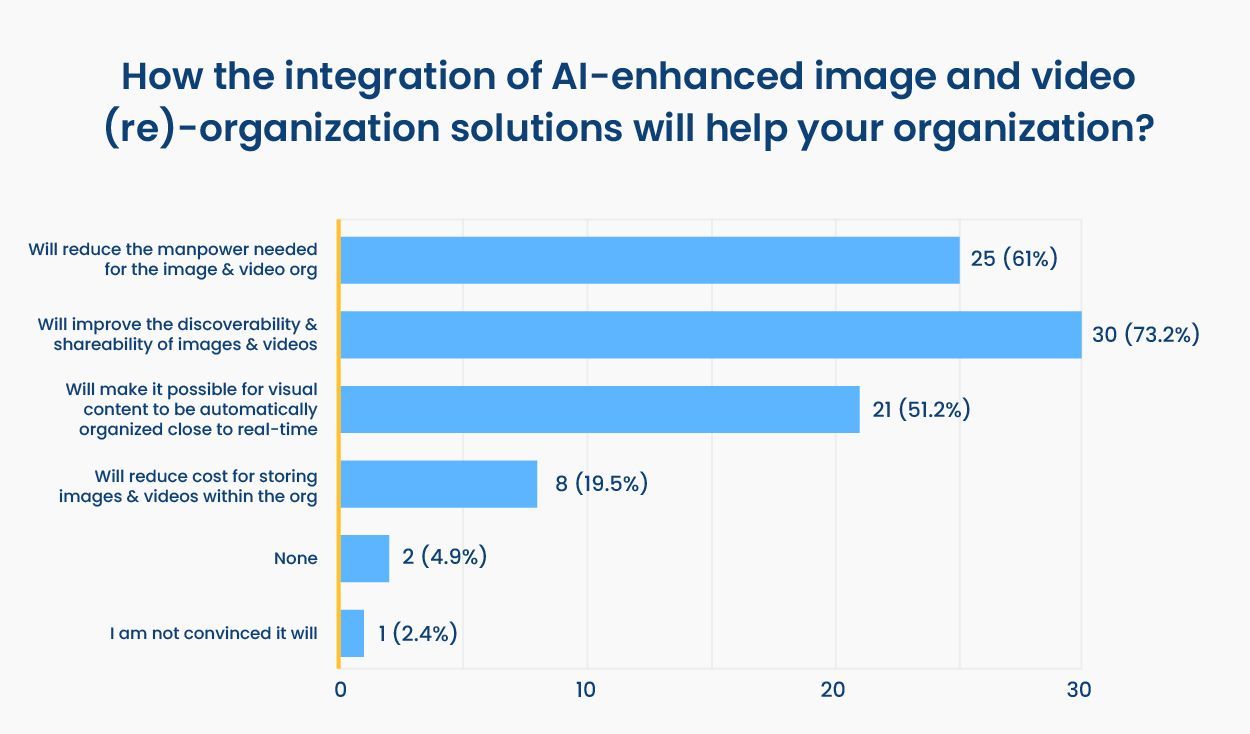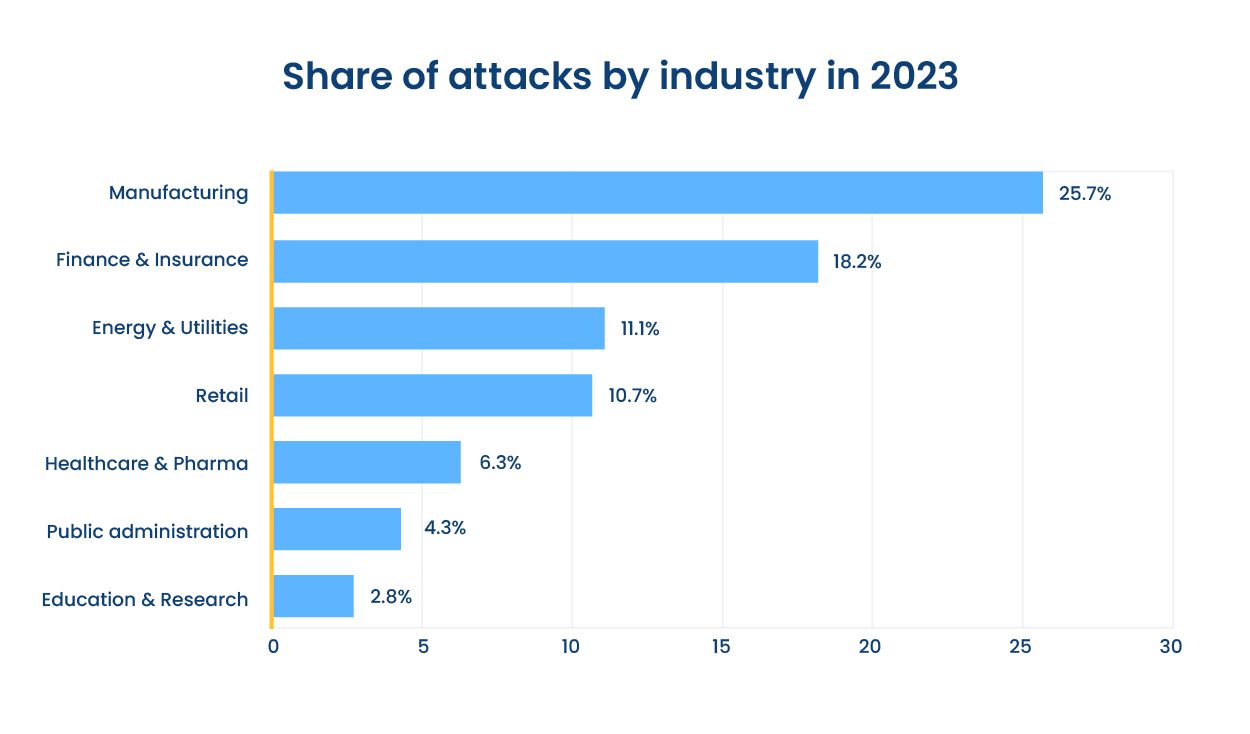Projected to reach a valuation of $16.18 billion by 2032, digital asset management is becoming critical. Media consumption has grown rapidly across various platforms, including streaming, gaming, social media, and digital commerce. As a result, companies are producing far more images, videos, and animations than ever before to catalyze their brand’s online presence and boost revenue. Additionally, with the internet unlocking access to global markets, companies are operating on an international scale and opting for cloud-based solutions to store and manage their digital assets.
With AI, and especially Generative AI, rapidly transforming almost all industries, its influence is beginning to make a significant mark on the Digital Asset Management (DAM) landscape as well.
Here are ten key trends shaping the future of the DAM industry, drawn from our research with customers and prospects, and supported by broader industry insights.
1. More SMBs are showing interest towards DAM
Digital asset management platforms were once considered tools built primarily for enterprises. But that’s no longer the case.The digital marketing industry is projected to hit $1.3 trillion by 2033, with nearly 58% of small businesses expected to leverage some form of digital marketing. Running content-heavy campaigns is now the norm for SMBs and mid-market teams, whether through social media, influencer partnerships, or UGC initiatives. As marketing and content-led growth become the default, even these businesses are turning to tools that help them move faster, stay consistent, and scale content production without chaos.
Our internal research reflects this shift. Nearly 60% of new digital asset management requirements now come from businesses with fewer than 20 seats.
These organizations aren’t looking for heavy, IT-led rollouts. Instead, they want instant access through free trials or pay-per-use models, flexible pricing that scales with growth, and integrations with everyday tools. For DAM vendors, this shift means rethinking the playbook by prioritizing faster onboarding, simplifying workflows, and supporting leaner teams that don’t have the luxury of long training cycles, complex setups, or huge budgets.

2. Integrations can make or break DAM adoption
A DAM platform is central to the media supply chain, but rarely works in isolation. Teams expect it to connect seamlessly with their existing workflows, from design and animation tools to project management, ads management, website building tools - the list goes on. In fact, Scott Brinker points out that one of the key factors in choosing any martech tool is how well it works with the rest of a company’s existing tool stack.
One way DAM providers can reduce this friction is by building native integrations with widely used tools like HubSpot, Salesforce, WordPress, or social media platforms. These integrations reduce the technical effort required by customer teams and help drive adoption. Our conversations with enterprise-scale teams, those with more than 400 employees, reinforce this point: 100% of them expected either native integrations with their core tools or the flexibility of headless DAM APIs to keep their workflows intact.
That expectation makes robust, well-documented APIs just as critical as native integrations. A robust API should support every core operation: uploading, managing, and searching assets, handling metadata, and more. These capabilities are especially essential for enterprises working with proprietary platforms or unique workflows.
When teams require fully customized interfaces and want the DAM to function within their existing platforms, DAM providers will need to offer headless architectures. This will let teams build workflows that align with how they already operate, rather than forcing them to conform to the DAM’s interface.

3. Customizable workflows with AI agents are critical functionality
Different teams within an organization use media assets in very different ways.
A brand team may need a multi-step approval chain before anything goes live. A product team might want assets to auto-tag themselves with SKU data and flow into product catalogs. Meanwhile, agencies might need client-specific folders with custom access controls and feedback loops.
A modern DAM must be flexible enough to support all these use cases. That means having the capability to handle assets through customizable workflows.
An approval workflow, for example, helps teams quickly evaluate and approve assets for distribution. Once approved, the asset moves smoothly to the next stage, whether that involves publishing or handoff. Similarly, a pre-publish workflow can be set up so the image is automatically resized, reviewed, and published to the right channels with minimal manual intervention.
AI agents are increasingly becoming integral to this automation. Acting as intelligent intermediaries, they can manage repetitive tasks such as tagging, categorization, routing files based on content type or usage intent, understanding a brand’s vocabulary, and even triggering follow-up actions like sending reminders or publishing approved assets. Their ability to learn from historical workflows enables more intelligent decision-making and faster execution, resulting in significantly improved efficiency across content pipelines.
Our internal research underscores this trend. We found that 75% of enterprise teams with more than 50 contributor seats consider AI agents critical for maintaining consistent metadata, understanding team-specific vocabulary, and automatically applying appropriate tags. This indicates that the presence or absence of AI is often a decisive factor when these teams evaluate or switch DAM platforms.
4. AI is changing the game by nuancing asset organization and search
AI is changing the game by reshaping how customers expect to organize and search for assets. According to Adobe’s Digital Trends 2025 report, over 78% of senior marketing executives see AI as critical to driving business efficiency. This sentiment echoes down to media content management as well, setting the need for smarter ways to handle the nuances of managing media files.
To meet these expectations, DAM providers will need to integrate AI-driven features that automate repetitive tasks like tagging, facial recognition, and duplicate detection, not only to reduce manual effort but also to streamline the entire asset management process.
Search functionality is another area where customer expectations are evolving. Our analysis shows that 60% of businesses consider AI-powered search vital. They want to locate assets using natural language, visual references, or even facial recognition across all asset types, including images, videos, and documents. This shift toward multi-modal search is transforming how teams interact with their assets, making discovery faster, more intuitive, and better aligned with their existing workflows.
Another trending feature request is duplicate asset detection. To cater to this, DAMs will need to utilize AI to scan visual content and automatically identify near-duplicates or exact matches. Comparing metadata, such as file names, creation dates, and tags, at the time of upload can help identify redundant files before they overload the system.
For DAM systems to stay competitive, investing in the development of the above features is an absolute must.

5.Built-in AI content creation is becoming essential for DAM systems
Content creation is quickly becoming one of the most valuable applications of AI in marketing. Approximately 72% of marketers using AI and automation report that it helps them personalize customer experiences. And more than half are already using AI to generate images and videos.
For DAM platforms, this would mean giving users the capability to generate AI content directly through the DAM, eliminating the need for a separate tool. From our conversations, we found that a quarter of DAM-focused prospects intended to choose a DAM with built-in content creation and editing tools, with a large chunk favoring integrations with existing AI tools used internally.
Capterra’s 2022 AI Marketing Survey confirms that 82% of marketers believe content generated by AI or machine learning software is just as good or even better than human-created content. This growing confidence in AI is pushing teams to expect more from their tools. For smaller agencies or lean creative teams, this opens up the ability to produce on-brand visuals at scale, without long wait times or large production budgets.
Even routine edits like simple edits like removing or changing the background of a product shoot, or generating videos from images or text should be supported within the DAM. Bringing these features into the platform makes sure creative teams can move faster without sacrificing quality.
6. An increased need to set AI guardrails
Although AI-generated content is widely trusted, using it without proper checks can create serious risks. Gen AI has become so human-like that it’s getting harder to tell what’s real and what’s not. Images, videos, and even voices can be faked using tools that are easily accessible. Some of this content ends up being used to mislead, scam, or harm reputations.
To combat these challenges, DAM systems will need to evolve in parallel and act as gatekeepers for content authenticity and brand safety.
Providers like Adobe have already invested in adopting a standard called C2PA. When integrated, it functions like a nutrition label for digital files, offering more visibility into the content’s history, available for access at any time. C2PA lets DAMs embed secure metadata into digital assets at key stages like creation, editing, and export. This metadata includes details like who created the asset, when it was made, and what changes were applied. It is cryptographically signed, traceable, and can even serve as legal evidence if required.
But content authenticity is only one piece of the puzzle. DAMs will also need to prevent misuse and ensure that every asset aligns with brand values.
NSFW and inappropriate content detection
This could be especially useful for fashion brands collecting user-submitted photos. To cater to such cases, DAMs must automatically scan uploads for nudity, violence, or hate symbols, and if something looks off, it must be blocked from entering the library.
Celebrity and copyrighted image flagging
Crucial to media companies working with freelance photographers, the DAM system would need to detect and flag any image containing recognizable celebrities, giving teams a chance to review and confirm proper usage rights.
Legal issues aren’t the only concern. There is also the matter of brand consistency. When content comes from different teams, regions, or contributors, results often vary. If AI tools are used without limits, there’s a real risk of off-brand visuals, mismatched messaging, or outdated assets being pushed live.
So to solve this modern DAMs would need to set visual guardrails:
Brand compliance checks: DAMs must possess capabilities that enable the automatic verification of the correct logo version being used and that brand colors adhere to the latest guidelines while flagging creatives that don’t meet the standards immediately.
A 2021 study by Marc (formerly Lucidpress) found that companies with consistent branding saw a 10–20% boost in overall growth and revenue. Yet, while 85% of businesses claim to have clear brand guidelines, only 30% apply them consistently across all touchpoints. That’s a problem AI with proper guardrails can solve.
Custom rules for visual consistency: DAMs should also enforce highly specific visual compliance rules, ranging from ethnicity, gender-inclusivity, cropping or padding requirements to object placement, aspect ratios, background consistency, and more.
7. 3D asset support can fuel more market reach
The demand for managing 3D assets is picking up fast. Industries like architecture, automotive, retail, gaming, and healthcare are starting to use 3D models as a regular part of their workflows. This shift is pushing the 3D DAM market forward, with projections showing it could grow from $29 billion in 2024 to almost $98 billion by 2034.
There are plenty of real-world use cases already. In retail, 3D files are behind virtual try-ons and product configurators that help customers get a better feel for what they’re buying. In other industries, they’re being used for simulations, prototypes, or design previews that save time and effort.
But most DAM systems today were built with 2D images in mind. Investing in capabilities of being able to support 3D formats like GLB, GLTF, OBJ, or STL, and integrate with other 3D asset creation tools like Blender, Unity, or Adobe Substance, will help serious DAM players expand their market reach.
8. DAMs still need to prioritize video asset management
3D assets may be a growing market, but video remains the leading format. 93% of marketers say video has helped them drive more sales. So it was no surprise when our user data corroborated this, showing that 40% of our DAM users are storing some form of video content in their asset repository.
This includes all the basic DAM capabilities used for image management, along with features like in-video search, auto-tagging of scenes or extracting short trailers for campaigns.
But DAMs will also need to support the entire video lifecycle from management to video delivery. This includes optimizing videos on the fly, adjusting resolution, converting formats, cropping for different platforms, and enabling Adaptive Bitrate Streaming (ABS) to ensure smooth playback across devices and network conditions. All of this should be backed by global CDN delivery to guarantee speed and reliability at scale.
9. Mobile-friendly DAM experiences matter
Teams today are distributed across various geographies, and work often occurs on the go. Since this is the new normal, DAM providers looking to stay ahead of the curve should offer the ability to operate via mobile through an app that allows:
- Uploading or reviewing assets directly from the phone
- Approving campaign visuals without needing a laptop
- Sharing links in Slack, Teams, or even WhatsApp from the DAM app instantly
Surpassing mere convenience, the provision of a mobile DAM app will help reduce feedback delays and speed up go-to-market timelines.
10. DAM security and compliance are non-negotiable
With cybercrime projected to cost businesses $1.5 trillion by the end of 2025, digital asset security is a business-critical requirement.
That’s why modern DAM systems must be built on trusted security frameworks. SOC 2 (Service Organization Control 2) compliance ensures that core infrastructure like storage, access controls, and monitoring are designed to prevent unauthorized access.
ISO 27001 brings a more holistic layer of protection, defining how information security is managed across people, processes, and technology. Data from ImageKit indicates that both these compliances are mandatorily required by organizations with over 500 employees, meaning DAMs must enforce strict access controls, maintain documented risk procedures, and ensure operational accountability at every step.
For DAM vendors looking to cater to EU businesses, GDPR compliance is mandatory since the law requires that all data tied to digital assets be stored within approved national or regional boundaries.
Robust security doesn’t have to come at the cost of usability, and DAMs looking to compete in today’s market are expected to deliver both. Features like Single Sign-On (SSO) let users log in through their existing corporate credentials, simplifying access while keeping authentication tightly controlled.
Complementing SSO, audit logs offer complete visibility into every asset interaction i.e. what was accessed, who accessed it, and when. For DAMs operating in high-compliance environments, that level of traceability is critical for maintaining accountability and control across the system.

Conclusion
The way brands create and manage content is evolving fast and traditional storage tools like Drive or Dropbox can't keep up with the scale, workflow complexity, or speed-to-market required today. DAM has already established itself as a rightful solution for media-based content becoming the backbone of modern content operations and its role will only grow from here.
Trusted by over 250,000 developers and 2,000+ businesses globally, ImageKit.io is enabling developers to ship faster, marketers to iterate freely, and your users to enjoy flawless visuals everywhere.
Secure your DAM needs by signing up with ImageKit today.




